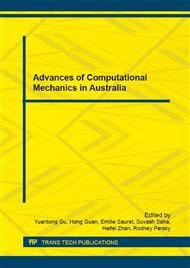p.360
p.366
p.372
p.378
p.385
p.391
p.397
p.403
p.409
Probabilistic Reliability Assessment of Slope Stability Problems with Genetic Algorithms
Abstract:
Uncertainty estimation and consideration in engineering is an important practice to design reliable structures especially in geotechnical engineering since the level of control with regards to the material parameters is much lower. Research has been conducted in order to assess the reliability of geotechnical works using probabilistic methods where challenges in computing the probability density function and predicting the critical failure region must be first overcome. One method to solve this problem is the Monte Carlo simulation; however it requires a high computational effort. Alternatively, reliability indices such as the Hasofer-Lind (HL) index can approximate the probability of failure Pf with fewer computations. Nonetheless, yet an optimisation problem needs to be solved. In this work, a genetic algorithm is developed to compute the HL index using the limit equilibrium method to search for the critical failure surface. Study cases and the analysis of the Vajont landslide are presented in order to illustrate the method.
Info:
Periodical:
Pages:
385-390
Citation:
Online since:
July 2016
Authors:
Price:
Сopyright:
© 2016 Trans Tech Publications Ltd. All Rights Reserved
Share:
Citation:


